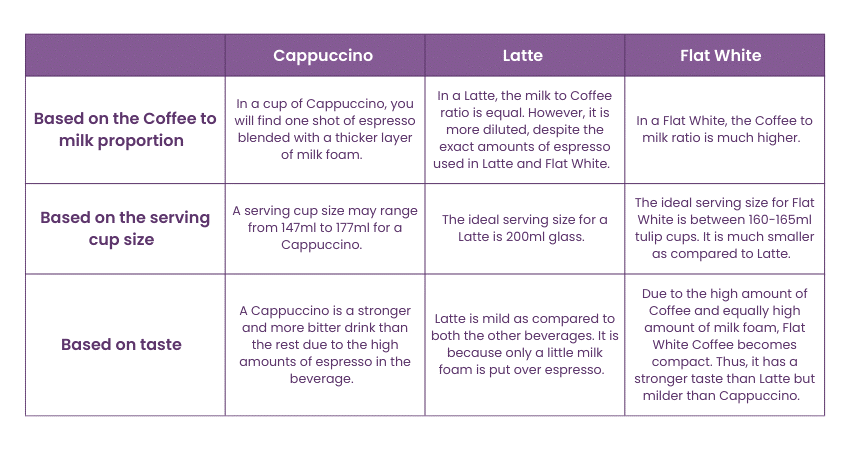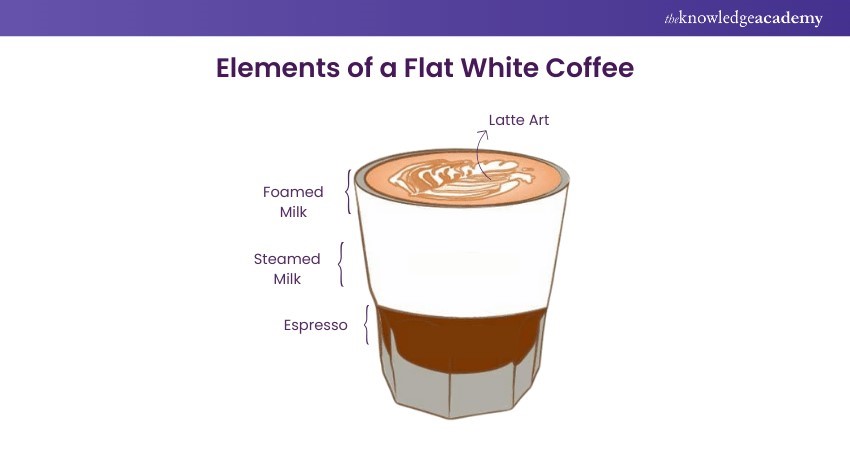We may not have the course you’re looking for. If you enquire or give us a call on +27 800 780004 and speak to our training experts, we may still be able to help with your training requirements.
We ensure quality, budget-alignment, and timely delivery by our expert instructors.

Coffee has always intrigued the masses. You will find people drinking the beverage in the morning, at brunch, for Hi-tea and even before bed. The reason? It is Coffee's strong and bitter taste, variety of flavours, and the energy boost caffeine provides.
According to International Coffee Organisation, during 2021-22, Coffee consumption reportedly exceeded its production by 3.1 million bags.
Thus, an increasing craze for the beverage implies that you might get stuck in a vicious cycle of choosing your favourite one. However, out of so many Types of Coffee Drinks, people might even confuse among several flavours and end up sticking to the old and basic ones.
Let's end the cycle and explore more about the exciting world of this beverage. Check out this step-by-step guide on “What is a Flat White Coffee,” where you will learn more about Flat White Coffee, including its origin and how you can make one.
Table of Contents
1) What is Flat White Coffee?
2) History and Origin of Flat White
3) Difference Between Cappuccino – Latte and Flat White
4) Different understandings of the drink
5) How to make Flat White Coffee?
a) Ingredients required
b) Equipment
c) Step by step method to make Flat White
d) Extra tips to make Your Flat White special
6) Conclusion
What is a Flat White Coffee?
You may have heard of Cappuccino, Latte, Espresso and Frappuccino, as these are some of the most popular and classic drinks. But have you ever come across Flat White? Flat White is relatively new to our ears. It is a new addition to the world of Coffee, often confused with Latte and Cappuccino. So, what is Flat White? Let's read about it in detail below.
Flat White is an espresso-based drink made by combining micro-foamed steamed milk with a single or double shot of espresso. When you pour micro-foamed milk over a single or double shot of espresso, this steamed milk infuses with air to create tiny bubbles along with a smooth and silky texture, and you get an aromatic and velvety Flat White.
To simplify, a Flat White is a creamier and more tender version of the Latte that is relatively small with a higher ratio of espresso than milk.
History and origin of Flat White
Flat White's origin has always been debated due to the tussle between Australia and New Zealand to mark the claims of Flat White. Despite its conflicting origins, it has become an important chapter in the history of coffee, collecting equal love from all parts of the world.
Flat White was introduced in the 1980s when Coffee enthusiasts wanted to shift from instant Coffee mixes to espresso-based drinks, but they wanted something similar rather than a basic Cappuccino. Thus, the professionals started putting large mountains of milk foam on top of it and called it ‘Flat.’
When Starbucks started serving Flat White as a substitute for Cappuccino and Latte, it became a popular beverage in the Western world.However, even today, a Flat White is prevalent as a substitute for Cappuccino and Latte due to the different techniques used by Baristas to prepare it.
Stand Out in Your Interview! Answer These Barista Interview Questions for No Experience with Confidence.
Difference between Cappuccino – Latte and Flat White
Many people get confused between the three drinks (Cappuccino, Latte and Flat White) as they are made using the same techniques. However, they cannot be substituted with each other. Then, how are they different? What special ingredient makes these three beverages differ from each other? Let's have a look at the differences in detail:

Thus, while espresso and milk remain constant in all of the Coffees mentioned above, the quantity and technique make them differ.
Different understandings of the drink
Flat white coffee making has multiple factors that take place. How your Flat White turns out heavily depends on where you get your coffee and the barista. Baristas aren't just adding milk; they prepare the milk in different ways; thick, frothy, foamy, piping hot, or lukewarm. Some people prefer to keep their traditional ratio of milk to coffee as the original measure, and others might tinker with that proportion.
Explore floristry methods and become an expert; register for our Floristry Introduction Course today!
How to make a Flat White
After you have a brief view of the Flat White, it’s time to learn how to make it. Although like the Latte, Flat White requires the same ingredients, the quantities differ.
Without further delay lets’ examine how Flat White is made:
Ingredients required
You will be required to have the following ingredients to make Flat White:
1) 19g finely ground Coffee
2) Milk (120ml)
Equipment
The types of equipment you will need to make a Flat White is as follows:
1) Espresso machine
2) Coffee puck
3) Tamper
4) Portafilter
5) Small milk jug
6) Mug of 230ml (preferable)
Step-by-step method to make a Flat White Coffee
You no longer need to wait at cafes and shops to get a steaming mug of Flat White; since making a Flat White is quite simple, you can make this Coffee at home for you and your loved ones. You just need to follow some simple steps. Let's have a look at what these steps are:
Step 1 - Fill a portafilter with finely ground 19g of Coffee
Step 2 - Use a tamper to evenly pressure the grounds, ensuring that the Coffee puck is even and Flat
Step 3 - Now, put the portafilter into the espresso machine
Step 4 - The next step is to place your mug under the machine and make a shot of espresso so it pours directly into the mug
Step 5 - Now, fill a jug with milk to the base of the spurt. Then, start building a wand in the centre of the milk, only half a cm below the surface. Also, tilt the jug while pouring in the milk
Step 6 - Turn on the steam and lower the milk jug until you hear a whistling sound
Step 7 - Once the milk level rises, move the steam wand under the surface to avoid creating more foam. When the milk is hot to the touch, turn the steam off
Step 8 - Further, give your milk jug a hard pat on the surface so that it bursts large air bubbles (if any). Circulate the milk around until it becomes a bit shiny and hold your cup at an angle, facing towards the milk jug and slowly pour it creating a thin line of milk at the top of the Coffee
Step 10 - Lastly, when your cup is ⅔ full, bring the milk jug tip closer to the surface of the Coffee and pour faster, pointing to the centre.
Your Flat White will be prepared, and you can serve it hot with a brownie or a dessert for your friends and family.
Many Baristas customise this beverage according to their requirements. Sometimes Baristas serve the milk in different ways, such as thick, frothy, foamy, piping hot or lukewarm. While others may like to keep it traditional.

Extra tips to Make your Flat White special
Here are some extra tips to make your Flat White extra special and rich in taste:
1) It is recommended to use full-fat whole milk
2) While pouring milk into the jug, tilt it slightly. It will produce a swirl effect while creating a thin layer of micro-foam
3) As you combine espresso with milk, try to create an even colour
4) The milk foam should gush out and sit on top of the Flat White, making a White blob. Keep pouring the milk into the blob until your cup is filled.
5) If you want to showcase creativity and turn the blob into a heart, just as the cup is almost full, pull the milk jug up to its earlier pouring position. Now, pull round the blob.
Conclusion
A Flat White Coffee has a creamy, velvety, yet strong Coffee. Despite its controversial origins, Flat White has gone on to take various forms and versions. We hope that through this blog, you were able to know in detail about Flat White, its origin and how to make one. It is your sign to make Coffee to comfort yourself!
If you want to know more about Coffee and how Coffee professionals work, join our Basic Barista Course now!
Frequently Asked Questions
Is a Flat White basically a latte?

A flat white is like a stronger, smoother version of a latte with less milk and a velvety texture.
How is a Flat White different from other coffees?

A flat white is a coffee with a smooth, velvety texture, higher coffee-to-milk ratio, and smaller serving size compared to other milk-based coffees like lattes or cappuccinos.
What are the other resources and offers provided by The Knowledge Academy?

The Knowledge Academy takes global learning to new heights, offering over 3,000 online courses across 490+ locations in 190+ countries. This expansive reach ensures accessibility and convenience for learners worldwide.
Alongside our diverse Online Course Catalogue, encompassing 19 major categories, we go the extra mile by providing a plethora of free educational Online Resources like News updates, Blogs, videos, webinars, and interview questions. Tailoring learning experiences further, professionals can maximise value with customisable Course Bundles of TKA.
What is the Knowledge Pass, and how does it work?

The Knowledge Academy’s Knowledge Pass, a prepaid voucher, adds another layer of flexibility, allowing course bookings over a 12-month period. Join us on a journey where education knows no bounds.
What are related Courses and blogs provided by The Knowledge Academy?

The Knowledge Academy offers various Industry Training, including Basic Barista Course, Facilitation Skills Training and Floristry Introduction Course. These courses cater to different skill levels, providing comprehensive insights into Quality Assurance vs Quality Control.
Our Business Skills Blogs covers a range of topics offering valuable resources, best practices, and industry insights. Whether you are a beginner or looking to advance your skills, The Knowledge Academy's diverse courses and informative blogs have you covered.
Upcoming Business Skills Resources Batches & Dates
Date
 Basic Barista Course
Basic Barista Course
Fri 25th Apr 2025
Fri 20th Jun 2025
Fri 29th Aug 2025
Fri 31st Oct 2025
Fri 19th Dec 2025






 Top Rated Course
Top Rated Course



 If you wish to make any changes to your course, please
If you wish to make any changes to your course, please


